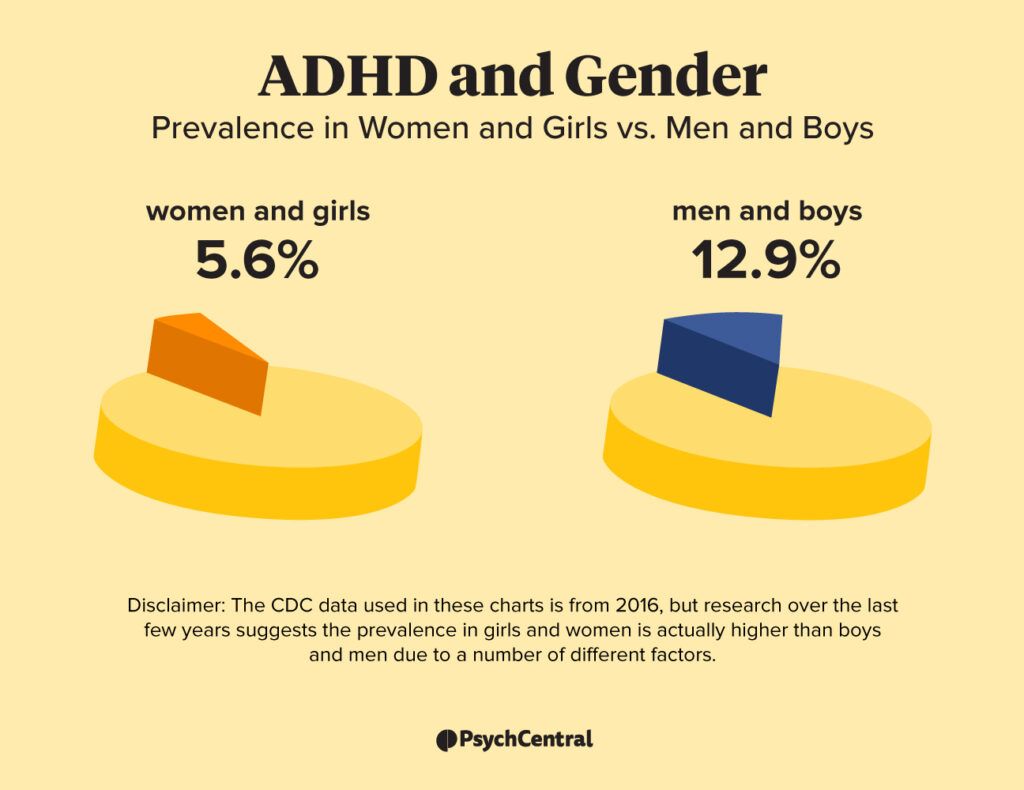People of different genders experience ADHD in unique ways, but further studies are still needed to uncover exactly why and how.

Attention deficit hyperactivity disorder (ADHD) affects people of all gender identities, but ADHD impacts folks of each gender differently.
While ADHD appears to be more common in males, females are often underdiagnosed or misdiagnosed due to differences in symptoms.
Understanding the gender differences in ADHD may help you become more aware of how symptoms present among women and girls versus men and boys.
Is ADHD more common in males or females? This answer is tricky.
According to the
But women and girls may be affected more than these statistics suggest.
“ADHD is just as prevalent in girls but is underdiagnosed due to different factors,” says Julia Edwards, a licensed mental health counselor and an ADHD-certified clinical services provider in Iowa.

“Boys and men are more likely than girls and women to be referred for services, even when their symptom profiles are exactly the same,” says Edwards, noting that this leads to higher diagnosis rates among boys and men.
A 2019 study suggests that ADHD diagnosis may be more easily missed among females during the diagnostic process.
Females are also less likely to be prescribed medication and receive a diagnosis because they don’t typically display the disruptive external symptoms associated with ADHD.
Based on Edwards’ experience living with ADHD and working with folks who have it, she’s noticed that different rates of diagnoses are often attributed to factors like cultural and gender biases and expectations.
Due to a lack of education on ADHD in women and girls, Edwards says they’re more likely to be improperly diagnosed with other mental health conditions like:
“For adults, the diagnosis process can be complex because it has to be very thorough,” Edwards says. “The later in life people try to seek a diagnosis, the more they have to take into consideration comorbidities, trauma, medical conditions, etc.”
Edwards notes that a mental or medical health professional will typically refer someone for ADHD testing. Then they’ll undergo a thorough psychological interview and various cognitive testing exercises to try to receive a diagnosis.
“The age of onset of ADHD symptoms is typically before the age of 12, but it can be as early as 2 to 3 years old,” Edwards says.
She notes that boys tend to show an earlier onset than girls because of the presentation of symptoms.
A 2021 study on adult-onset ADHD suggests that symptoms that present later in life could be due to childhood symptoms that weren’t addressed by a medical professional, among other factors.
Edwards says that ADHD is a lifelong neurodevelopmental condition, which means that people don’t “grow out of it.” But symptoms can change over time, especially with an early diagnosis and proper treatment.
“When untreated, symptoms can intensify during the teenage years because of hormones,” Edwards adds.
For example, changes in estrogen can affect the intensity and presentation of ADHD symptoms at different stages of life, such as:
- puberty
- monthly menstrual cycle
- perimenopause
- menopause
Edwards has noticed that the diagnosis rate in women (between the ages of 30 to 45) has been rapidly increasing, particularly in recent years due to pandemic-related changes in structure and environment.
“As a therapist specializing in adult ADHD, about 90% of my ADHD clients are women who’ve been diagnosed later in life,” she adds.
ADHD symptoms differ depending on a person’s gender, age, and other factors.
“I personally don’t believe that there are no significant differences in the symptoms between men and women,” Edwards says.
“What’s different are the behaviors and presentation of the same symptoms because of the structural and functional differences between the male and female brain,” she says.
ADHD symptoms in women and girls
According to Edwards, women are less likely to be externally hyperactive and impulsive than men. She notes that internal hyperactivity in women can be in the form of overthinking, intrusive thoughts, and negative self-talk.
Other internalized symptoms of inattention, distractibility, and hyperactivity among women and girls with ADHD may include:
- maladaptive daydreaming
- anxiety
- depression
- spacing out during conversations
- easily losing focus
- auditory processing disorder
- forgetfulness
- eating disorders
- hypersexuality
- impatience
- body-focused repetitive behaviors (e.g., skin picking, hair pulling, leg bouncing)
- fatigue
- insomnia
- crying with deep emotion, anger, and feelings of guilt and shame
- shyness due to social anxiety and sensory sensitivities
They may also experience the following symptoms of rejection sensitive dysphoria (RSD):
- perfectionism
- people-pleasing
- codependency
- body dysmorphia or negative body image
- low self-esteem
- overachieving or underachieving
- intense emotional reactions and overwhelm
A note on RSD
RSD is not formally recognized by the Diagnostic and Statistical Manual of Mental Disorders, 5th edition (DSM-5) as a clinical diagnosis. Also, the symptoms associated with this phenomenon are not unique to ADHD and may be linked to other mental health conditions.
ADHD symptoms in men and boys
On the other hand, men and boys with ADHD are more likely to show external behaviors like:
- hyperactivity (e.g., fidgeting)
- disruptive behavior
- frequently losing items
- interrupting others during conversations
- aggressive behaviors
- high risk behaviors (e.g., substance misuse, speeding, unhealthy sexual behaviors, excessive financial spending)
Edwards notes that RSD can present among men in the same intensity as women. Men can also experience low self-esteem and insecurities, but most of the time it’s externalized as:
- anger
- apathy
- self-centeredness
- seeming insensitive to other people’s emotions
- teasing others or being sarcastic
- needing to be right or proving others wrong
- defensiveness
Edwards notes that heightened emotions or emotional dysregulation for males can look more like temper tantrums and anger outbursts, too.
“There are many men who are emotionally sensitive, and because of gender bias, they [experience] shame for being in touch with their emotions instead of meeting society’s expectations of ‘being tough or strong,’” Edwards says.
People of different genders experience ADHD in unique ways.
Yet further studies are still needed to uncover exactly how ADHD impacts men, women, and other gender identities. More research can help to increase education, remove stigma, and improve treatment for those who live with ADHD and are looking for help.
If you’re curious about ADHD symptoms and how they may impact you based on your gender, consider speaking with a therapist.
“An early diagnosis means prevention of future complications,” Edwards says. “But the ultimate goal regardless of age and gender is to improve quality of life and having the emotional freedom to be our true selves.”
